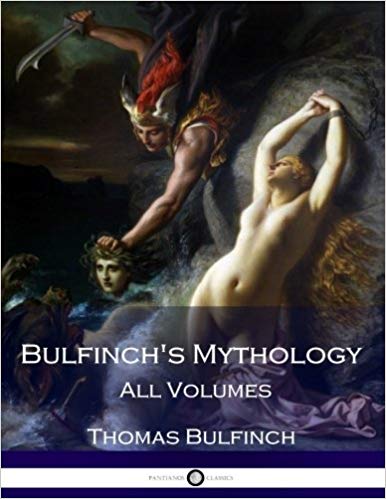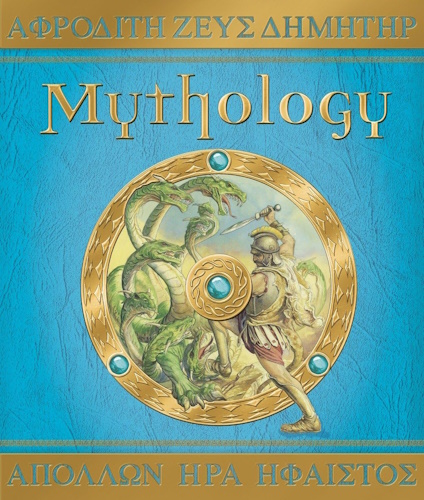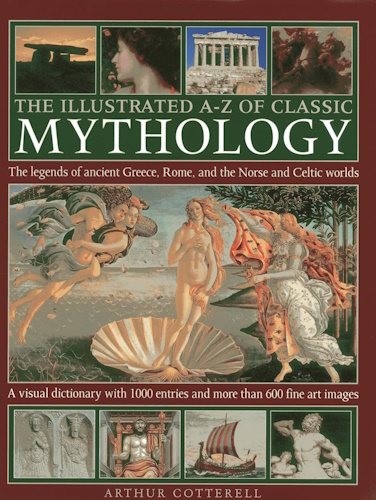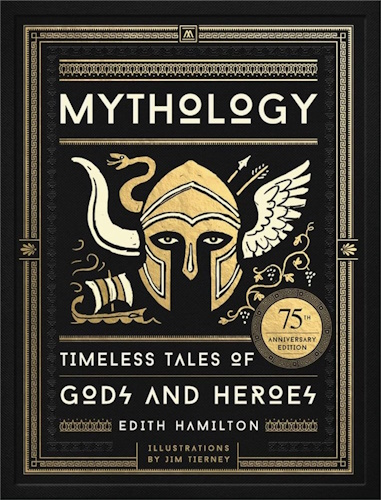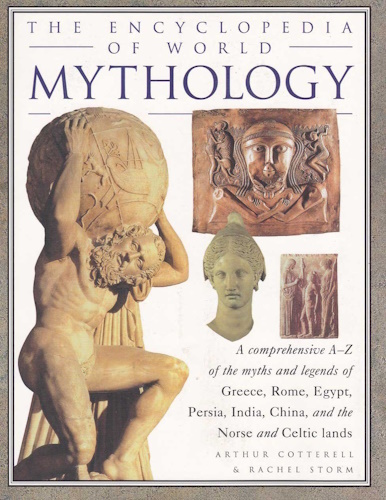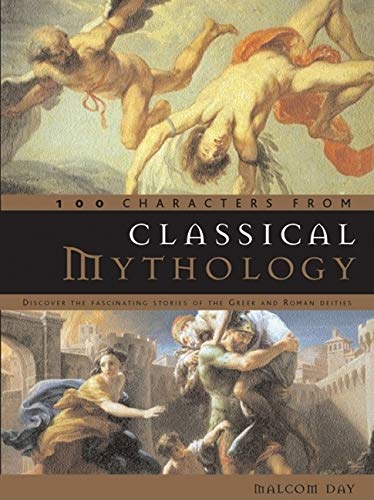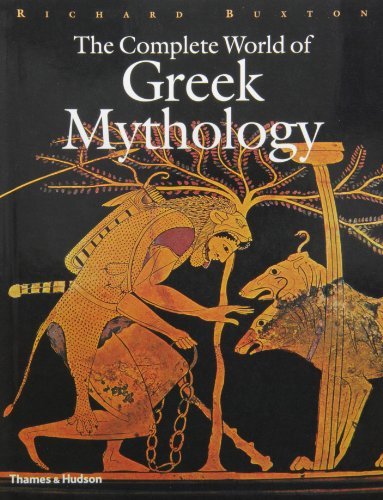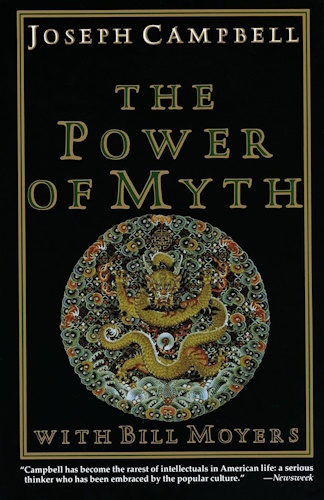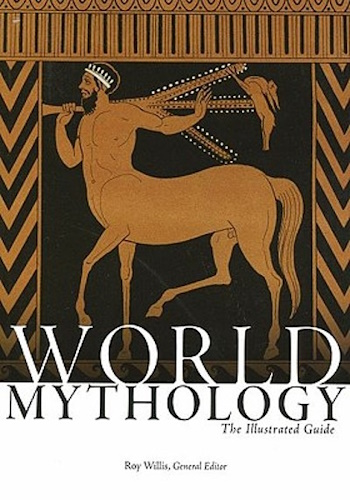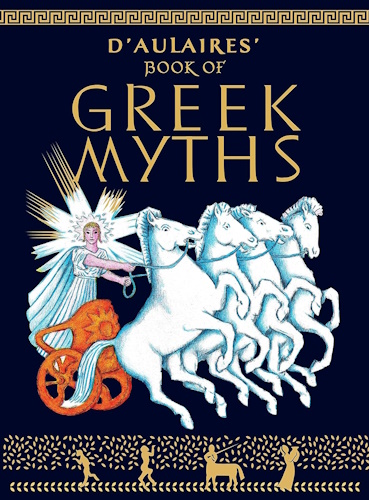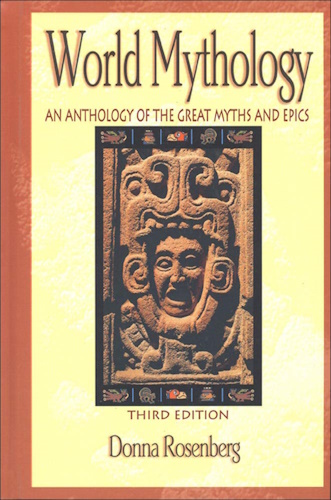
![]()
![]()
CHAPTER XVII.
THE GOLDEN FLEECE- MEDEA
THE GOLDEN FLEECE
IN very ancient times there lived in Thessaly a king and queen name Athamas and Nephele. They had two children, a boy and a girl. After a time Athamas grew indifferent to his wife, put her away, and took another. Nephele suspected danger to her children from the influence of the step-mother, and took measures to send them out of her reach. Mercury assisted her, and gave her a ram with a golden fleece, on which she set the two children, trusting that the ram would convey them to a place of safety. The ram vaulted into the air with the children on his back, taking his course to the East, till when crossing the strait that divides Europe and Asia, the girl, whose name was Helle, fell from his back into the sea, which from her was called the Hellespont,- now the Dardanelles. The ram continued his career till he reached the kingdom of Colchis, on the eastern shore of the Black Sea, where he safely landed the boy Phryxus, who was hospitably received by AEetes, king of the country. Phryxus sacrificed the ram to Jupiter, and gave the Golden Fleece to AEetes, who placed it in a consecrated rove, under the care of a sleepless dragon.
There was another kingdom in Thessaly near to that of Athamas, and ruled over by a relative of his. The king AEson, being tired of the cares of government, surrendered his crown to his brother Pelias on condition that he should hold it only during the minority of Jason, the son of AEson. When Jason was grown up and came to demand the crown from his uncle, Pelias pretended to be willing to yield it, but at the same time suggested to the young man the glorious adventure of going in quest of the Golden Fleece, which it was well known was in the kingdom of Colchis, and was, as Pelias pretended, the rightful property of their family. Jason was pleased, with the thought and forthwith made preparations for the expedition. At that time the only species of navigation known to the Greeks consisted of small boats or canoes hollowed out from trunks of trees, so that when Jason employed Argus to build him a vessel capable of containing fifty men, it was considered a gigantic undertaking. It was accomplished, however, and the vessel named "Argo," from the name of the builder. Jason sent his invitation to all the adventurous young men of Greece, and soon found himself at the head of a band of bold youths, many of whom afterwards were renowned among the heroes and demigods of Greece. Hercules, Theseus, Orpheus, and Nestor were among them. They are called the Argonauts, from the name of their vessel.
The "Argo" with her crew of heroes of Thessaly and having touched at the Island of Lemnos, thence crossed to Mysia and thence to Thrace. Here they found the sage Phineus, and from him received instruction as to their future course. It seems the entrance of the Euxine Sea was impeded by two small rocky islands, which floated on the surface, and in their tossings and heavings occasionally came together, crushing and grinding to atoms any object that might be caught between them. They were called the Symplegades, or Clashing Islands. Phineus instructed the Argonauts how to pass this dangerous strait. When they reached the islands they let go a dove, which took her way between the rocks, and passed in safety, only losing some feathers of her tail. Jason and his men seized the favourable moment of the rebound, plied their oars with vigour, and passed safe through, though the islands closed behind them, and actually grazed their stern. They now rowed along the shore till they arrived at the eastern end of the sea, and landed at the kingdom of Colchis.
Jason made known his message to the Colchian king, AEetes, who consented to give tip the golden fleece if Jason would yoke to the plough two fire-breathing bulls with brazen feet, and sow the teeth of the dragon which Cadmus had slain, and from which it was well known that a crop of armed men would spring up, who would turn their weapons against their producer. Jason accepted the conditions, and a time was set for making the experiment. Previously, however, he found means to plead his cause to Medea, daughter of the king. He promised her marriage, and as they stood before the altar of Hecate, called the goddess to witness his oath. Medea yielded, and by her aid, for she was a potent sorceress, he was furnished with a charm, by which he could encounter safely the breath of the fire-breathing bulls and the weapons of the armed men.
At the time appointed, the people assembled at the grove of Mars, and the king assumed his royal seat, while the multitude covered the hill-sides. The brazen-footed bulls rushed in, breathing fire from their nostrils that burned up the herbage as they passed. The sound was like the roar of a furnace, and the smoke like that of water upon quick-lime. Jason advanced boldly to meet them. His friends, the chosen heroes of Greece, trembled to behold him. Regardless of the burning breath, he soothed their rage with his voice, patted their necks with fearless hand, and adroitly slipped over them the yoke, and compelled them to drag the plough. The Colchians were amazed; the Greeks shouted for joy. Jason next proceeded to sow the dragon's teeth and plough them in. And soon the crop of armed men sprang up, and, wonderful to relate! no sooner had they reached the surface than they began to brandish their weapons and rush upon Jason. The Greeks trembled for their hero, and even she who had provided him a way of safety and taught him how to use it, Medea herself, grew pale with fear. Jason for a time kept his assailants at bay with his sword and shield, till, finding their numbers overwhelming, he resorted to the charm which Medea had taught him, seized a stone and threw it in the midst of his foes. They immediately turned their arms against one another, and soon there was not one of the dragon's brood left alive. The Greeks embraced their hero, and Medea, if she dared, would have embraced him too.
It remained to lull to sleep the dragon that guarded the fleece, and this was done by scattering over him a few drops of a preparation which Medea had supplied. At the smell he relaxed his rage, stood for a moment motionless, then shut those great round eyes, that had never been known to shut before, and turned over on his side, fast asleep. Jason seized the fleece and with his friends and Medea accompanying, hastened to their vessel before AEetes the king could arrest their departure, and made the best of their way back to Thessaly, where they arrived safe, and Jason delivered the fleece to Pelias, and dedicated the "Argo" to Neptune. What became of the fleece afterwards we do not know, but perhaps it was found after all, like many other golden prizes, not worth the trouble it had cost to procure it.
This is one of those mythological tales, says a late writer, in which there is reason to believe that a substratum of truth exists, though overlaid by a mass of fiction. It probably was the first important maritime expedition, and like the first attempts of the kind of all nations, as we know from history, was probably of a half-piratical character. If rich spoils were the result it was enough to give rise to the idea of the golden fleece.
Another suggestion of a learned mythologist, Bryant, is that it is a corrupt tradition of the story of Noah and the ark. The name "Argo" seems to countenance this, and the incident of the dove is another confirmation.
Pope, in his "Ode on St. Cecilia's Day," thus celebrates the launching of the ship "Argo," and the power of the music of Orpheus, whom he calls the Thracian:
"So when the first bold vessel dared the seas,High on the stern the Thracian raised his strain,
While Argo saw her kindred trees
Descend from Pelion to the main.
Transported demigods stood round,
And men grew heroes at the sound."
In Dyer's poem of "The Fleece" there is an account of the ship "Argo" and her crew, which gives a good picture of this primitive maritime adventure:
"From every region of AEgea's shoreThe brave assembled; those illustrious twins
Castor and Pollux; Orpheus, tuneful bard;
Zetes and Calais, as the wind in speed;
Strong Hercules and many a chief renowned.
On deep Ioclos' sandy shore they thronged,
Gleaming in armour, ardent of exploits;
And soon, the laurel cord and the huge stone
Uplifting to the deck, unmoored the bark;
Whose keel of wondrous length the skilful hand
Of Argus fashioned for the proud attempt;
And in the extended keel a lofty mast
Upraised, and sails full swelling; to the chiefs
Unwonted objects. Now first, now they learned
Their bolder steerage over ocean wave,
Led by the golden stars, as Chiron's art
Had marked the sphere celestial," etc.
Hercules left the expedition at Mysia, for Hylas, a youth beloved by him, having gone for water, was laid hold of and kept by the nymphs of the spring, who were fascinated by his beauty. Hercules went in quest of the lad, and while he was absent the "Argo" put to sea and left him. Moore, in one of his songs, makes a beautiful allusion to this incident:
"When Hylas was sent with his urn to the fount,Through fields of light and with heart full of play,
Light rambled the boy over meadow and mount,
And neglected his task for the flowers in the way.
"Thus many like me, who in youth should have tasted
The fountain that runs by Philosophy's shrine,
Their time with the flowers on the margin have wasted,
And left their light urns all as empty as mine."
MEDEA AND AESON
Amid the rejoicings for the recovery of the Golden Fleece, Jason felt that one thing was wanting, the presence of AEson, his father, who was prevented by his age and infirmities from taking part in them. Jason said to Medea, "My spouse, would that your arts, whose power I have seen so mighty for my aid, could do me one further service, take some years from my life and add them to my father's." Medea replied, "Not at such a cost shall it be done, but if my art avails me, his life shall be lengthened without abridging yours." The next full moon she issued forth alone, while all creatures slept; not a breath stirred the foliage, and all was still, To the stars she addressed her incantations, and to the moon; to Hecate,* the goddess of the under-world, and to Tellus the goddess of the earth, by whose power plants potent for enchantment are produced. She invoked the gods of the woods and caverns, of mountains and valleys, of lakes and rivers, of winds and vapours. While she spoke the stars shone brighter, and presently a chariot descended through the air, drawn by flying serpents. She ascended it, and borne aloft made her way to distant regions, where potent plants grew which she knew how to select for her purpose. Nine nights she employed in her search, and during that time came not within the doors of her palace nor under any roof, and shunned all intercourse with mortals.
* Hecate was a mysterious divinity sometimes identified with Diana and sometimes with Proserpine. As Diana represents the moonlight splendour of night, so Hecate represents its darkness and terrors. She was the goddess of sorcery and witchcraft, and was believed to wander by night along the earth, seen only by the dogs, whose barking told her approach.
She next erected two altars, the one to Hecate, the other to Hebe, the goddess of youth, and sacrificed a black sheep, pouring libations of milk and wine. She implored Pluto and his stolen bride that they would not hasten to take the old man's life. Then she directed that AEson should be led forth, and having thrown him into a deep sleep by a charm, had him laid on a bed of herbs, like one dead. Jason and all others were kept away from the place, that no profane eyes might look upon her mysteries. Then, with streaming hair, she thrice moved round the altars, dipped flaming twigs in the blood, and laid them thereon to burn. Meanwhile the cauldron with its contents was got ready. In it she put magic herbs, with seeds and flowers of acrid juice, stones from the distant east, and sand from the shore of all-surrounding ocean; hoar frost, gathered by moonlight, a screech owl's head and wings, and the entrails of a wolf. She added fragments of the shells of tortoises, and the liver of stags- animals tenacious of life- and the head and beak of a crow, that outlives nine generations of men. These with many other things "without a name" she boiled together for her purposed work, stirring them up with a dry olive branch; and behold! the branch when taken out instantly became green, and before long was covered with leaves and a plentiful growth of young olives; and as the liquor boiled and bubbled, and sometimes ran over, the grass wherever the sprinklings fell shot forth with a verdure like that of spring.
Seeing that all was ready, Medea cut the throat of the old man and let out all his blood, and poured into his mouth and into his wound the juices of her cauldron. As soon as he had completely imbibed them, his hair and beard laid by their whiteness and assumed the blackness of youth; his paleness and emaciation were gone; his veins were full of blood, his limbs of vigour and robustness. AEson is amazed at himself, and remembers that such as he now is, he was in his youthful days, forty years before.
Medea used her arts here for a good purpose, but not so in another instance, where she made them the instruments of revenge. Pelias, our readers will recollect, was the usurping uncle of Jason, and had kept him out of his kingdom. Yet he must have had some good qualities, for his daughters loved him, and when they saw what Medea had done for AEson, they wished her to do the same for their father. Medea pretended to consent, and prepared her cauldron as before. At her request an old sheep was brought and plunged into the cauldron. Very soon a bleating was heard in the kettle, and when the cover was removed, a lamb jumped forth and ran frisking away into the meadow. The daughters of Pelias saw the experiment with delight, and appointed a time for their father to undergo the same operation. But Medea prepared her cauldron for him in a very different way. She put in only water and a few simple herbs. In the night she with the sisters entered the bed chamber of the old king, while he and his guards slept soundly under the influence of a spell cast upon them by Medea. The daughters stood by the bedside with their weapons drawn, but hesitated to strike, till Medea chid their irresolution. Then turning away their faces, and giving random blows they smote him with their weapons. He, starting from his sleep, cried out, "My daughters, what are you doing? Will you kill your father?" Their hearts failed them and their weapons fell from their hands, but Medea struck him a fatal blow, and prevented his saying more.
Then they placed him in the cauldron, and Medea hastened to depart in her serpent-drawn chariot before they discovered her treachery or their vengeance would have been terrible. She escaped, however, but had little enjoyment of the fruits of her crime. Jason, for whom she had done so much, wishing to marry Creusa, princess of Corinth, put away Medea. She, enraged at his ingratitude, called on the gods for vengeance, sent a poisoned robe as a gift to the bride, and then killing her own children, and setting fire to the palace, mounted her serpent-drawn chariot and fled to Athens, where she married King AEgeus, the father of Theseus, and we shall meet her again when we come to the adventures of that hero.
The incantations of Medea will remind the reader of those of the witches in "Macbeth." The following lines are those which seem most strikingly to recall the ancient model:
"Round about the cauldron go;In the poisoned entrails throw.
Fillet of a fenny snake
In the cauldron boil and bake;
Eye of newt and toe of frog,
Wool of bat and tongue of dog,
Adder's fork and blind-worm's sting,
Lizard's leg and howlet's wing;
Maw of ravening salt-sea shark,
Root of hemlock digged in the dark," etc.
Macbeth, Act IV. Scene I.
And again:
Macbeth.- What is't you do?Witches.- A deed without a name.
There is another story of Medea almost too revolting for record even of a sorceress, a class of persons to whom both ancient and modern poets have been accustomed to attribute every degree of atrocity. In her flight from Colchis she had taken her young brother Absyrtus with her. Finding the pursuing vessels of AEetes gaining upon the Argonauts, she caused the lad to be killed and his limbs to be strewn over the sea. AEetes on reaching the place found these sorrowful traces of his murdered son; but while he tarried to collect the scattered fragments and bestow upon them an honourable interment, the Argonauts escaped.
In the poems of Campbell will be found a translation of one of the choruses of the tragedy of "Medea," where the poet Euripides has taken advantage of the occasion to pay a glowing tribute to Athens, his native city. It begins thus:
"O haggard queen! to Athens dost thou guideThy glowing chariot, steeped in kindred gore;
Or seek to hide thy damned parricide
Where peace and justice dwell for evermore?"
-
Urantia Book, 44:0.11 - The Celestial Artisans
Never in your long ascendancy will you lose the power to recognize your associates of former existences. Always, as you ascend inward in the scale of life, will you retain the ability to recognize and fraternize with the fellow beings of your previous and lower levels of experience. Each new translation or resurrection will add one more group of spirit beings to your vision range without in the least depriving you of the ability to recognize your friends and fellows of former estates.
-
Princess Bride 1987 Wallace Shawn (Vizzini) and Mandy Patinkin (Inigo Montoya)
Vizzini: HE DIDN'T FALL? INCONCEIVABLE.
Inigo Montoya: You keep using that word. I do not think it means what you think it means. -
Urantia Book, 117:4.14 - The Finite God
And here is mystery: The more closely man approaches God through love, the greater the reality -- actuality -- of that man. The more man withdraws from God, the more nearly he approaches nonreality -- cessation of existence. When man consecrates his will to the doing of the Father's will, when man gives God all that he has, then does God make that man more than he is.
-
Urantia Book, 167:7.4 - The Talk About Angels
"And do you not remember that I said to you once before that, if you had your spiritual eyes anointed, you would then see the heavens opened and behold the angels of God ascending and descending? It is by the ministry of the angels that one world may be kept in touch with other worlds, for have I not repeatedly told you that I have other sheep not of this fold?"
-
Urantia Book, Foreword - 0:12.12 - The Trinities
But we know that there dwells within the human mind a fragment of God, and that there sojourns with the human soul the Spirit of Truth; and we further know that these spirit forces conspire to enable material man to grasp the reality of spiritual values and to comprehend the philosophy of universe meanings. But even more certainly we know that these spirits of the Divine Presence are able to assist man in the spiritual appropriation of all truth contributory to the enhancement of the ever-progressing reality of personal religious experience—God-consciousness.
-
Urantia Book, 1:4.3 - The Mystery Of God
When you are through down here, when your course has been run in temporary form on earth, when your trial trip in the flesh is finished, when the dust that composes the mortal tabernacle "returns to the earth whence it came"; then, it is revealed, the indwelling "Spirit shall return to God who gave it." There sojourns within each moral being of this planet a fragment of God, a part and parcel of divinity. It is not yet yours by right of possession, but it is designedly intended to be one with you if you survive the mortal existence.
-
Urantia Book, 1:4.1 - The Mystery Of God
And the greatest of all the unfathomable mysteries of God is the phenomenon of the divine indwelling of mortal minds. The manner in which the Universal Father sojourns with the creatures of time is the most profound of all universe mysteries; the divine presence in the mind of man is the mystery of mysteries.
-
Urantia Book, 1:4.6 - The Mystery Of God
To every spirit being and to every mortal creature in every sphere and on every world of the universe of universes, the Universal Father reveals all of his gracious and divine self that can be discerned or comprehended by such spirit beings and by such mortal creatures. God is no respecter of persons, either spiritual or material. The divine presence which any child of the universe enjoys at any given moment is limited only by the capacity of such a creature to receive and to discern the spirit actualities of the supermaterial world.
-
Urantia Book, 11:0.1 - The Eternal Isle Of Paradise
Paradise is the eternal center of the universe of universes and the abiding place of the Universal Father, the Eternal Son, the Infinite Spirit, and their divine co-ordinates and associates. This central Isle is the most gigantic organized body of cosmic reality in all the master universe. Paradise is a material sphere as well as a spiritual abode. All of the intelligent creation of the Universal Father is domiciled on material abodes; hence must the absolute controlling center also be material, literal. And again it should be reiterated that spirit things and spiritual beings are real.
-
Urantia Book, 50:6.4 - Planetary Culture
Culture presupposes quality of mind; culture cannot be enhanced unless mind is elevated. Superior intellect will seek a noble culture and find some way to attain such a goal. Inferior minds will spurn the highest culture even when presented to them ready-made.
-
Urantia Book, 54:1.6 - True And False Liberty
True liberty is the associate of genuine self-respect; false liberty is the consort of self-admiration. True liberty is the fruit of self-control; false liberty, the assumption of self-assertion. Self-control leads to altruistic service; self-admiration tends towards the exploitation of others for the selfish aggrandizement of such a mistaken individual as is willing to sacrifice righteous attainment for the sake of possessing unjust power over his fellow beings.
-
Urantia Book, 54:1.9 - True And False Liberty
How dare the self-willed creature encroach upon the rights of his fellows in the name of personal liberty when the Supreme Rulers of the universe stand back in merciful respect for these prerogatives of will and potentials of personality! No being, in the exercise of his supposed personal liberty, has a right to deprive any other being of those privileges of existence conferred by the Creators and duly respected by all their loyal associates, subordinates, and subjects.
-
Urantia Book, 54:1.8 - True And False Liberty
There is no error greater than that species of self-deception which leads intelligent beings to crave the exercise of power over other beings for the purpose of depriving these persons of their natural liberties. The golden rule of human fairness cries out against all such fraud, unfairness, selfishness, and unrighteousness.
